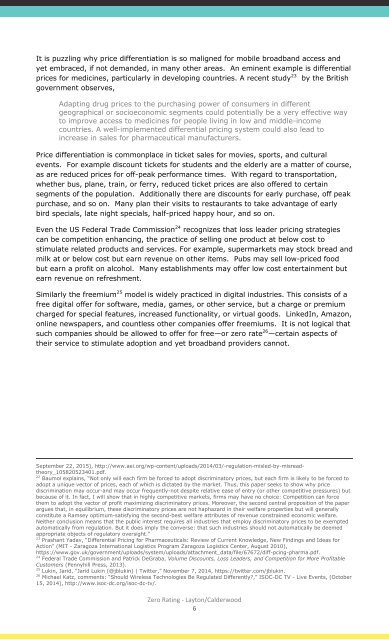Layton
Layton
Layton
You also want an ePaper? Increase the reach of your titles
YUMPU automatically turns print PDFs into web optimized ePapers that Google loves.
It is puzzling why price differentiation is so maligned for mobile broadband access and<br />
yet embraced, if not demanded, in many other areas. An eminent example is differential<br />
prices for medicines, particularly in developing countries. A recent study 23 by the British<br />
government observes,<br />
Adapting drug prices to the purchasing power of consumers in different<br />
geographical or socioeconomic segments could potentially be a very effective way<br />
to improve access to medicines for people living in low and middle-income<br />
countries. A well-implemented differential pricing system could also lead to<br />
increase in sales for pharmaceutical manufacturers.<br />
Price differentiation is commonplace in ticket sales for movies, sports, and cultural<br />
events. For example discount tickets for students and the elderly are a matter of course,<br />
as are reduced prices for off-peak performance times. With regard to transportation,<br />
whether bus, plane, train, or ferry, reduced ticket prices are also offered to certain<br />
segments of the population. Additionally there are discounts for early purchase, off peak<br />
purchase, and so on. Many plan their visits to restaurants to take advantage of early<br />
bird specials, late night specials, half-priced happy hour, and so on.<br />
Even the US Federal Trade Commission 24 recognizes that loss leader pricing strategies<br />
can be competition enhancing, the practice of selling one product at below cost to<br />
stimulate related products and services. For example, supermarkets may stock bread and<br />
milk at or below cost but earn revenue on other items. Pubs may sell low-priced food<br />
but earn a profit on alcohol. Many establishments may offer low cost entertainment but<br />
earn revenue on refreshment.<br />
Similarly the freemium 25 model is widely practiced in digital industries. This consists of a<br />
free digital offer for software, media, games, or other service, but a charge or premium<br />
charged for special features, increased functionality, or virtual goods. LinkedIn, Amazon,<br />
online newspapers, and countless other companies offer freemiums. It is not logical that<br />
such companies should be allowed to offer for free—or zero rate 26 —certain aspects of<br />
their service to stimulate adoption and yet broadband providers cannot.<br />
September 22, 2015), http://www.aei.org/wp-content/uploads/2014/03/-regulation-misled-by-misreadtheory_105820523401.pdf.<br />
22 Baumol explains, “Not only will each firm be forced to adopt discriminatory prices, but each firm is likely to be forced to<br />
adopt a unique vector of prices, each of which is dictated by the market. Thus, this paper seeks to show why price<br />
discrimination may occur-and may occur frequently-not despite relative ease of entry (or other competitive pressures) but<br />
because of it. In fact, I will show that in highly competitive markets, firms may have no choice: Competition can force<br />
them to adopt the vector of profit maximizing discriminatory prices. Moreover, the second central proposition of the paper<br />
argues that, in equilibrium, these discriminatory prices are not haphazard in their welfare properties but will generally<br />
constitute a Ramsey optimum-satisfying the second-best welfare attributes of revenue constrained economic welfare.<br />
Neither conclusion means that the public interest requires all industries that employ discriminatory prices to be exempted<br />
automatically from regulation. But it does imply the converse: that such industries should not automatically be deemed<br />
appropriate objects of regulatory oversight.”<br />
23 Prashant Yadav, “Differential Pricing for Pharmaceuticals: Review of Current Knowledge, New Findings and Ideas for<br />
Action” (MIT - Zaragoza International Logistics Program Zaragoza Logistics Center, August 2010),<br />
https://www.gov.uk/government/uploads/system/uploads/attachment_data/file/67672/diff-pcing-pharma.pdf.<br />
24 Federal Trade Commission and Patrick DeGraba, Volume Discounts, Loss Leaders, and Competition for More Profitable<br />
Customers (Pennyhill Press, 2013).<br />
25 Lukin, Jarid, “Jarid Lukin (@jblukin) | Twitter,” November 7, 2014, https://twitter.com/jblukin.<br />
26 Michael Katz, comments: “Should Wireless Technologies Be Regulated Differently?,” ISOC-DC TV - Live Events, (October<br />
15, 2014), http://www.isoc-dc.org/isoc-dc-tv/.<br />
Zero Rating - <strong>Layton</strong>/Calderwood<br />
6


